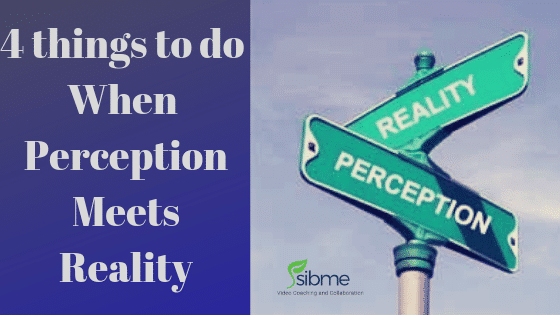
When perception meets reality, real change begins.
In part 2 of our 9 part webinar series, Dr. Tonya Goree of Francone Elementary School said that using video evidence to coach teachers was “where perception meets reality.” That’s a powerful statement. But it’s also a frightening experience. Our classrooms can be near-sacred spaces, and realizing that our view of things might be inaccurate is…well…terrifying. But when perception meets reality, overcoming that fear and moving toward action can be the key to growth.
So find someone you trust who understands your classroom. This can be a colleague, a mentor, or a coach. Just make sure you trust them. Whether your the one who’s reality isn’t quite what you thought it was, or you’re trying to alter someone else’s perception, consider these four things as you move from perception….through reality…to success!
1.Recognize the internal conflict
In his book, Focus on Teaching, Jim Knight claims that one of the underlying challenges of changing the daily practices of a teacher is the connection between his or her profession and their core identity. Knight compares teaching to parenthood. It’s a good analogy. If you suddenly realized that you had been raising your children incorrectly you would likely experience some variation on the stages of grief. At the very least, there would likely be some anger and denial before you moved to acceptance.
The same is true for most teachers. While we all sincerely claim that we want to improve our practice, it can be challenging to accept that our efforts to touch the lives of dozens (or hundreds) of kids might have been less than perfect. Changing how we teach now might mean we failed to reach one of our students in the past.
So, as a defense mechanism, we build perceptions of ourselves as flawless educators. That’s why many of us are so defensive when someone points out our flaws in the classroom.
When video makes those imperfections a reality, it can be too much to bear. When perception meets reality, we need an empathetic voice to help us move beyond fear and denial to acceptance.
We’re no experts on empathy. Luckily, Brené Brown is just up the road at the University of Houston, and she is. Here’s a quick overview from her on how best to be empathetic…
The first step is the hardest. Be patient with one another before moving on to step two. Take time to discuss the emotions you feel as you start to see reality in your classroom. It’ll make the next 3 steps go by much smoother.
2. Move from identity to actions
In a recent study from Harvard University, teachers who watched themselves teach on video “rated their own instruction lower than comparison teachers [who didn’t watch themselves on video].” The self-criticism that comes along when perception meets reality can be daunting. It’s important to move past the things you did wrong and towards things you can do.
Pick 1-3 tangible goals.
Most of us are familiar with S.M.A.R.T. goals at this point. If you’re not, here’s a pretty good primer from Mind-Tools. Using the acronym can be a helpful template, but there is an even more key point that often disconnects people from success. Make sure your goals bridge the gap between the reality you see and the reality you want to see. If you’re not careful, you can get caught up in the minutiae of each letter in the S.M.A.R.T. acronym and completely miss the fact that you are trying to change a very specific thing.
So once you’ve labored over your 1-3 goals, take a second to evaluate reality again. It’s a good time to review the video of your teaching one more time. Look at the area you want to change. If you achieved the goals you’ve set, would reality change in your classroom. Would you address your competing commitments? How?
3. Find the disconnect between current actions and desired outcomes
In their book Immunity to Change, Drs. Robert Kegan and Lisa Lahey recommend another gut check after setting your goals. The authors suggest two questions to ask yourself once you set a goal for change:
- What am I doing/not doing instead of the actions needed to accomplish my goal? (Here’s another perfect place to evaluate video of your professional practice to gather the evidence you need to answer this question.)
- What hidden competing commitments have I made that prevent me from accomplishing this goal.
Question number two is another chance to examine the fears you explored in step one. Kegan and Lahey suggest filling up a “worry box” by reading your goals, the actions you are doing/not doing instead, and completing the sentence “I worry that…” as many times as possible.
For example, perhaps you want to give students opportunities to respond to questions and demonstrate mastery of learning objectives in your class. After reviewing video of your class, you might observe that you spend 80% of class-time talking, leaving little time for student response. Some of the things you might put in your worry box are:
- Students will get off task if I allow them to talk.
- I will lose control of the class.
- Students will not know the answers to my questions.
These statements in your worry box then help you identify the hidden competing commitments keeping you from giving students opportunities to respond:
- I want to maintain control of my classroom.
- Keeping students quiet means I can assume they understand what I’m saying.
It’s important to take time to really think about why your perception of your classroom is so different from reality. What competing commitments might stand at the root of the disconnect between perception and reality? Finding those competing commitments can be eye opening, and set you on the path to success.
4. Do one thing
At this point, you’re likely exhausted. And for good reason! This is why it’s so important to find an empathetic and trusted colleague to help you through this process. Having someone to walk with you through this journey can make the process more bearable, but eventually you’ll have to take a leap of faith on your own.
And there’s only one way to do it.
Take.
One.
Step.
We could use all sorts of metaphors about Rome being built and eating an elephant, but we won’t waste your time. At this point, you should look at your goals, find one thing you can successfully do right now and just do it!
Getting an early win is crucial to your continued success. That’s why picking one thing that will set you on your path is so critical. Find an easy win, and accomplish it. It will make the next action a little easier to know you’ve already accomplished something. Celebrate that success, and then get to work on the next step.
And when perception meets reality the next time, your new reality will be right where you think it is.

